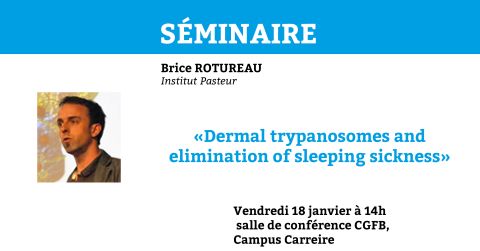Dermal trypanosomes and elimination of sleeping sickness
Trypanosoma brucei gambiense is a protist parasite transmitted by the bite of the tsetse fly and responsible for Human African Trypanosomiasis (HAT) or sleeping sickness in Western and Central Africa. WHO aims to eliminate HAT by 2030. This target has in part been encouraged by the success of surveillance efforts that rely partly on detecting extracellular trypanosomes in human blood. However, the parasite density in the blood periodically fluctuates during an infection and can be sometimes low and undetectable. More importantly, in trypanotolerant asymptomatic people, living parasites remain undetectable, raising the question of a possible role of reservoirs for these latent infections. We have recently demonstrated some unexpected striking features of the parasite biology and transmission. In mice infected with bioluminescent trypanosomes, parasites first developed in the extravascular compartment of the skin before they could be detected in the blood. Although blood parasites remained barely detectable during the entire course of infection, populations of parasites were continuously detected in the skin with a dynamic distribution and in variable densities. Naïve tsetse flies that were allowed to feed on infected mice, with parasites in the skin but not in the blood, became infected, and the ingested trypanosomes further completed their cyclical development in the vector. To verify the presence of skin-dwelling parasites in humans, we conducted prospective studies in different HAT endemic regions of Guinea, Côte d’Ivoire, and Cameroon where parasites are found in skin biopsies from all confirmed cases. Strikingly, most latent infection cases, that are normally left untreated, were also bearing parasites in their skin. These breakthrough observations strongly suggest that skin-dwelling parasite populations in both patients and latent cases are likely to significantly contribute to the maintenance of the parasite transmission. These results question the current screening strategy and raises the possibility of eliminating the disease, by considering a significant reservoir of parasites that has remained hidden so far. Hence, we are currently studying the cellular mechanisms driving parasite extravasation to the skin and developing new diagnostic tools targeting this crucial anatomical reservoir.


